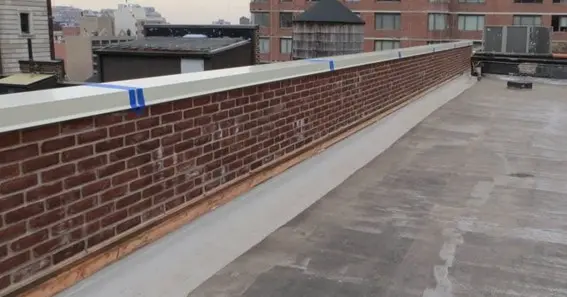What is a parapet? A simple but intriguing inquiry leads to a fascinating look at building planning and engineering. Parapets, which line buildings, bridges, and defenses, are more than merely decorative. They affect a building’s appearance and function. In this article learn more about what is a parapet, the background, purpose, and types of parapets to realize how difficult something seemingly simple is.
What Is A Parapet?
A parapet is a low wall or barrier along a bridge, terrace, or rooftop. It looks good and is robust, but its primary purpose is to prevent falls from high areas. Fortification parapets once sheltered troops while they watched or battled attackers. Modern buildings employ them to hide roof equipment and improve their appearance. Understanding what is a parapet requires understanding its many architectural and design uses.
Stone, brick, concrete, and metal are all possible parapet materials. Crenellations and coping may be artistic. Parapets can prevent wind, noise, and privacy concerns. They have cultural and symbolic meanings as well as utilitarian applications. They symbolize authority, security, and grandeur. By understanding parapet sections, you may better understand their role in architectural design and how they affect the constructed world.
Also Read N: What Is Loitering? Modern Laws Of Loitering
Significance Of Parapets

From the outset, parapets existed. Castles and defenses needed parapets in the Middle Ages. They hid and made arrow and weapon shooting possible for the defenders. Battlements, with their merlons and crenels, are ordinary military parapets. This history explains how the parapet evolved from a protective need to an architectural feature. To answer what is a parapet? consider its historical significance.
Parapets protected and signified power in medieval times. Different cultures built and designed parapets differently, reflecting their wants and building styles. Beyond their practical and symbolic purposes, parapets have shaped cityscapes and modern architecture. Looking at what parapets meant in the past helps us understand how they have influenced building design and how they are used today.
Also Read P: What Is The Age Of Consent In Texas? Exceptions And Close In Age Exemptions
Functional Roles Of Parapets
Parapets protect people from falling off roofs, balconies, and steps, but they also have other essential functions. As fire barriers, they slow fire spread between nearby buildings. They prevent wind uplift, stabilizing flat roofs in windy areas. Parapets hide unsightly rooftop equipment like solar panels and HVAC systems, improving the building’s appearance. Parapets are crucial to modern structures, making the answer to what is a parapet? more complete, given their multiple functions.
Parapets also reduce noise pollution as sound barriers. They can be built from metal, concrete, or masonry to match modern or traditional architecture. To maximize their use, parapets can be used with gutters and sewage systems. Because of their multiple functions, parapets help buildings be safe, durable, and attractive.
Types Of Parapets
Each parapet has its characteristics and applications. A solid parapet that reaches the ground provides maximum seclusion and security. Parapets with decorative holes let air and light in while keeping people safe. These cavinz are used on walkways and bridges without a building. Crenelated parapets, resembling medieval battlements, combine purpose and style. Each style of parapet answers what is a parapet? differently, which shows how valuable this construction tool is.
Parapets In Modern Architecture

Parapets have evolved to meet architectural design and safety criteria. They are employed in primary, clean buildings and complex, traditional ones. Architects employ parapets to give structures clean lines and a better shape. Today, reinforced concrete, steel, and glass are employed to produce durable, attractive parapets. Modern buildings use parapets, demonstrating their versatility and providing us with a new perspective on what is a parapet?
Aesthetic Contributions Of Parapets
Parapets enhance a building’s appearance and function. When decorated with sophisticated designs or sculptures, they may make a room look large and elegant. They can also visually connect building sections, giving them a cohesive look. Parapets shape cities’ environment and character. When you ask, what is a parapet? you should know that they improve the appearance and architecture of buildings.
Parapets In Different Cultures
Many architectural styles feature parapets. Islamic parapets include intricate geometric patterns and calligraphy for ornament and purpose. Parapets on Chinese and Japanese buildings are often embellished with symbols. Castles and temples have these. The Gothic, Renaissance, and Baroque styles of Western architecture have featured parapets, each with its unique meaning. Comparing parapets from different civilizations helps us comprehend what a parapet is by illustrating how distinct and significant they are.
Future Of Parapets
New parapet developments are likely as buildings evolve. Sustainable parapet designs may use live walls or solar panels. Materials science may make parapet systems lighter, stronger, and more flexible. Denser urbanization will make parapet design more about safety and attractiveness. Parapets’ past includes transformation and growth, and their future is promising. This expands What is a parapet?
Conclusion
Finally, what is a parapet? A multipurpose architectural feature that combines safety, functionality, and beauty. From military fortifications to modern architecture, the parapet has been an integral feature of building design. Its diverse forms and regional interpretations demonstrate its flexibility and eternal importance. In the future, parapets will adapt to new tools and design methods. Understanding what is a parapet helps you comprehend how it has shaped building and will in the future. That should enough for what is a parapet.
FAQ
How To Use Modern Balconies?
Parapets protect people from falling over rooftops and platforms in modern structures. Fire, wind uplift, and roof tool hiding are also protected.
How Did Parapets Begin?
Medieval defenders employed parapets, as did ancient civilizations. They protected troops and allowed siege weapon launches.
What Are Typical Parapet Materials?
Concrete, steel, brick, and glass are used to make parapets. The building style and wall function determine the material.
Can Parapets Be Both Functional And Attractive?
Yes, parapets can be used and evaluated. They improve safety and structure and beautify the building with varied styles and ornaments.
How Do Parapets Enhance Building Appearance?
Parapets enhance the elegance and grandeur of buildings. They add character to cityscapes by creating smooth lines, connecting building sections, and defining skylines.
Sources:










